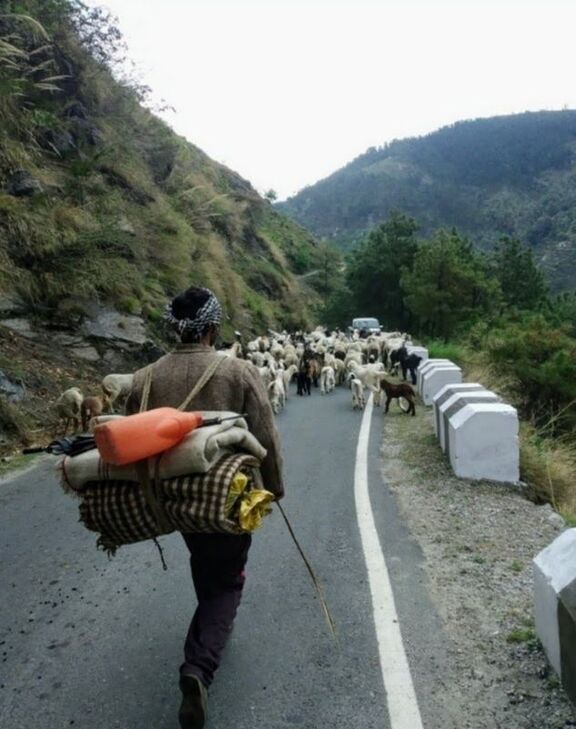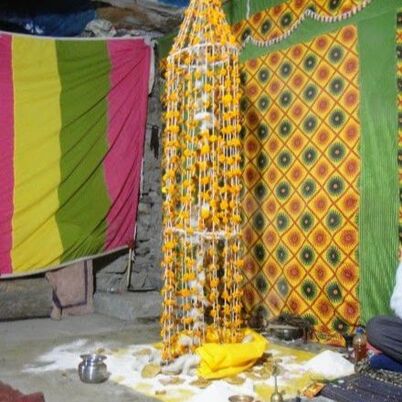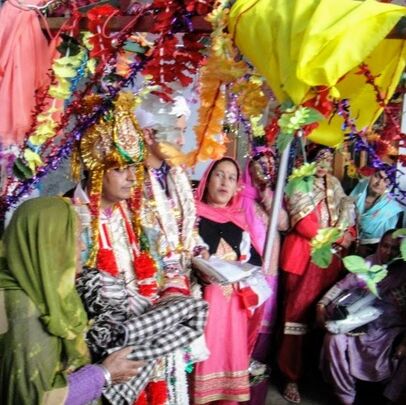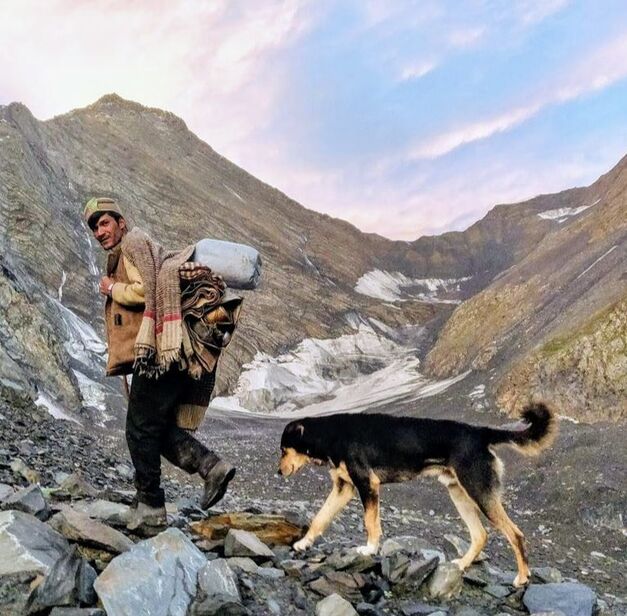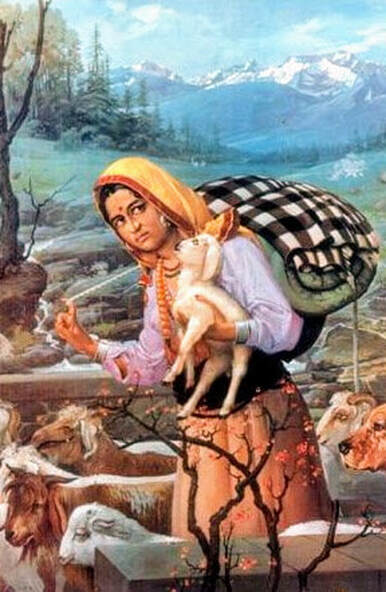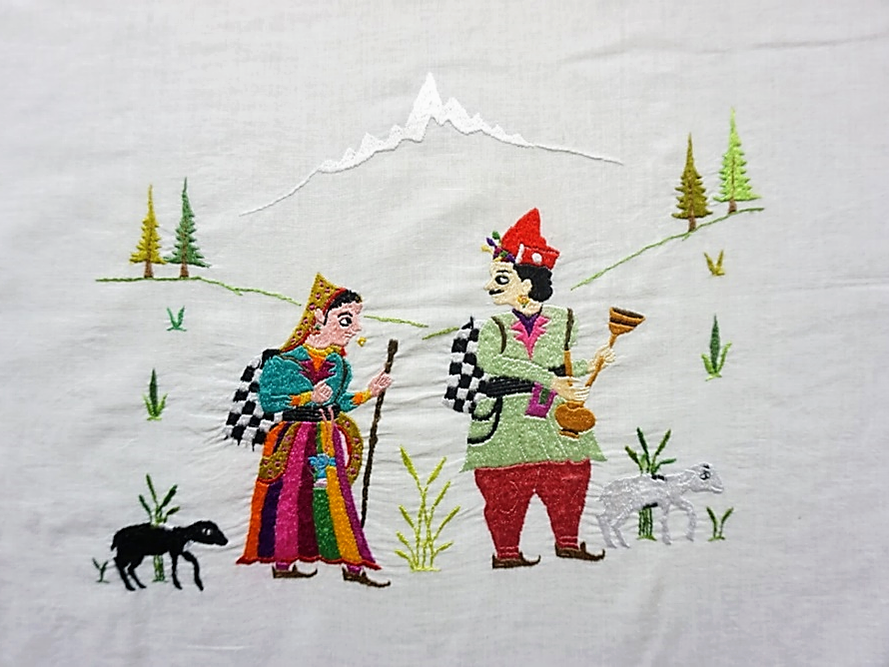Cultural Representation and Materiality of Gaddi Pastoralism
By
Aayushi Malhotra
On the way up to the renowned tourist destination of Dharamshala in Himachal Pradesh, large herds of sheep and goats managed by a few Gaddi shepherds through their distinct sounds and loud whistles remain a familiar spectacle. Often dressed in their traditional clothes carrying the everyday essentials on their back, these men brilliantly guide the flock of hundreds on the busiest highway. Such vivid visuals often get imprinted in the travellers' memories who visit the state for its natural sceneries and touristy locales. Their brief encounters with the Gaddi shepherds create the imagery of Himalayan pastoralism and shape the common perceptions around it. Often the visualizations narrated through popular travel stories and mountain memorabilia help portray the Gaddi pastoral culture outside the academic domains, mainly in terms of their material and tangible attributes.
Pahadi Pastoralists and Popular Representations
In and around the state of Himachal Pradesh, Gaddi remains a term often used in common parlance for all the migratory shepherds irrespective of their community affiliations. It is almost treated as a synonym to any migratory herder overlooking the specific details that differentiate the Gaddis from other pastoral populations of the state. At the same time, the pastoral identity is used as a communal representation for the whole of the Gaddi population that remains highly diversified. Doing so overshadows the community's internal variations and neglects the prevalent intersectional caste, class, and livelihood differences. For example, in his recent public address at Palampur in Kangra, the chief minister of Himachal Pradesh made a statement that 'his government is committed to the development of Gaddi community and to do so, they will be launching many schemes that help the shepherds in making their animal husbandry practices more profitable' (ANI News, 2021). Such homogenising statements emphasising the Gaddis' pastoral identity in connection to the development of the whole population group remain common in political discourse despite the declining practices. It essentially derives from the historical linkages and cultural relationship to the pastoral identity that continues to persist in the Gaddi material culture, invoking a deep sense of nostalgia and community feeling.
Gaddi Symbolics and Materiality
Far from the much-debated ecological and economic concerns around Gaddi pastoralism, it is the cultural element and materiality that brings the community together. Material objects are the symbols and tools of culture that have a social utility and remain important for mediating cultural boundaries (Grassby, 2005). Through such objects that are invested with traditional meanings, Gaddis largely represent the pastoral culture of Himachal Pradesh and form a dominant scheduled tribe, both numerically and politically. Their challenging agro-pastoral practices, remote locations of residence, economic vulnerabilities, along with the distinct cultural characteristics involving seasonal transhumance across the mighty Dhauladhar and Pir Panjal range, earned them the constitutional status in the first place. Their profound connection with the pastoral practices has immensely shaped their worldviews and the aspects of their material culture. This materiality entangled in everyday practices remains common even to those households that have abandoned the pastoral profession and have diversified long back but still hold on to its fragments as cultural representation and pride.
One of the most common material aspects of Gaddi culture remains their attire. Gaddi shepherds are commonly seen dressed in beige coloured woollen coats irrespective of the season as it tends to protect them from the rains, cold, and heat by regulating the inner temperature. This woven piece of clothing comes into being after a long process of painstaking labour. Starting with the seasonal shearing of sheep wool, it goes through many steps using local techniques and knowledge to become an attire that symbolises the cultural identity. The wool processing within the Gaddi community involves both men and women of the household. Men use the small handheld wooden spindles to wrap the thread while women work on the bigger spinning wheels. This yarn is then weaved into the fabric using the wooden handlooms that remain an essential material object found across the Gaddi houses, though not in very functional conditions in recent times. Manoj Chauhan, a young gaddi filmmaker from Bharmour in Chamba, has captured the nuances of this process in detail in his documentary titled 'Paal' (2018). This attire that has long been traditionally associated with the Gaddi shepherd is called as Paal and is also worn by other community men, especially the elders.
Even though the Gaddi livelihoods are diversifying, and the market around them are expanding, spinning wheels, handlooms, and sheep wool remain an integral part of their cultural heritage in a form or another. Wool is primarily required for the Gaddi traditional dresses, including chola- a knee-length woollen dress for men and a dora- a long black woollen cord wrapped around the waist by men and women, worn on several occasions. Apart from that, it also remains significant in other ceremonial rituals like that of Nuala as well. It is a specific cultural event among the Gaddis where garlands made of sheep wool are used, and an offering of a mature ram to Lord Shiva is also observed. Apart from being a celebration, Nuala remains a performance of communal identity concerning the myth of origin and devotion to Lord Shiva who conferred the Gaddis with shepherding duties (Wagner 2013).
Another important material signifier of the Gaddi pastoralism is the chequered blankets called gardu or pattu that the shepherds carry along with them on their migration cycles. These blankets weaved using black and white wool in different patterns are rain resistant and save the shepherds from weather extremities. Apart from this incredible utility, these blankets are also exchanged during marriage ceremonies and are an integral part of the Gaddi bridal trousseau. However, the market-bought fancy and soft blankets are gradually replacing this coarse hand-made pattus, limiting their use for pastoral or ceremonial purposes.
Apart from the everyday objects derived as by-products from their pastoral practices, hukka-a smoking pipe made up of wood and metal used to smoke tobacco is also an important cultural signifier of Gaddi pastoralism. The shepherds carry the traditional hukkas on their journeys that are perceived to symbolise their devotion towards Lord Shiva. On the migration cycles, typical luggage of a Gaddi shepherd includes the hukka, some lightweight aluminium utensils, pattus, and food supplies. To store the food material, Gaddis traditionally use small pouches made up of goat skin called khalru that prevent the external weather fluctuations from spoiling the raw material. Collectively, these material objects embody much more symbolic value than just their functional significance.
Treasuring Pastoral Culture and Gaddi Identity
The objects of the material culture of Gaddis are widely acknowledged across Himachal Pradesh and especially within the district Chamba, to where all the Gaddis trace back their origin. Their traditional and historical artefacts are widely celebrated and also find a special place among the exhibits at the famous Bhuri Singh Museum in Chamba. The long-standing association with pastoral practices has a great role in carving out the everyday culture of Gaddis as it influences their traditional costumes and rituals to dance and visual representations. Examples can be found in the form of the famous painting of a Gaddi woman- Her Grace The Gaddan by S.Sobha Singh and a depiction of a Gaddi couple with their sheep and goats embroidered on well-known chamba rumaals that are often bought as souvenirs by the tourists. Such artforms and portraits not only adore the walls of Gaddi households but are also commonly found across many government offices, hotels, and homes in the whole state.
These popular imageries are well accepted within the Gaddi community despite their waning linkages with pastoralism. The intertwined nature of their pastoral practices and culture indicates the broader significance of pastoralism beyond its economic value, both for material reality and symbolism. It remains a means of shared cultural representation for them and also, collectively extends to form a popular image of Himalayan pastoralists. However, with the recent livelihood shifts and declining pastoral practices in the region, associated materiality is also gradually transitioning. It is not only eliminating the cultural distinctiveness of Gaddis but presenting more critical questions on the issues of identity and representation that remain valid for other pastoral contexts as well.
|
20/08/2021
|
Explore I Share
|
Aayushi Malhotra
|
Aayushi Malhotra is a graduate in Social Anthropology from the Department of Anthropology, University of Delhi, and is pursuing her Ph.D. from the Department of Humanities and Social Sciences, BITS PILANI. Her research focuses on the transitions in Gaddi pastoralism along with the shifting significance of these practices using a socio-ecological lens.
|
